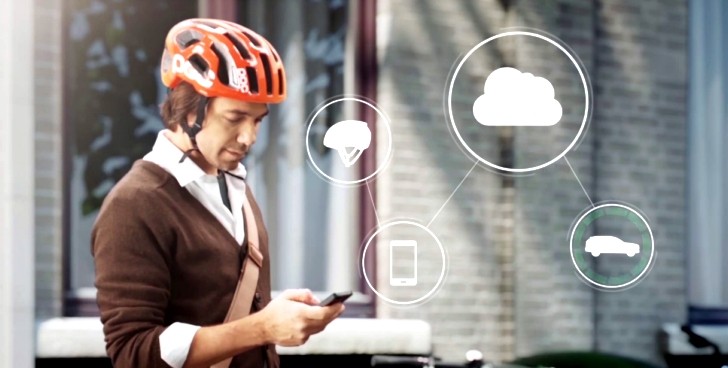Modern technology and the internet connectivity are becoming more and more involved in traffic safety and Volvo’s latest “connected helmet” project is just the newest addition to the “may become reality” ideas for safer streets. The project involves Volvo, Ericsson and powersports gear manufacturer Poc in an all-Swedish endeavor to curb the number of “SMIDSY” crashes.
Often invoked as an excuse after an impact involving a car and a cyclist or motorcyclist the “sorry mate, I didn’t see you” line has become a special category in the annals of road crashes. Still, in certain cases the driver, or rider, for what’s worth indeed has no visibility around blind corners and in other similar conditions.
Basically, drivers will get a HUD alert on their windshields, while riders will have a light flashing on their helmets, telling them that they are on a potential “collision course” with another vehicle. The location data is uploaded to the Volvo cloud and shared between all the users, internet connectivity being thus able to surpass poor light and visibility caused by night, fog, rain, and will also work seamlessly around blind corners.
While it appears that Volvo’s cloud system will be used for safety-related, sharing one’s location with one more system may be seen as one extra way sometimes sensitive data could be accessed by others.
So far, the system is only tested with Volvo cars, but the same technology will most likely be fairly easy to expand to other brands. Meanwhile, V2X (vehicle-to-environment) are also envisaged, with the vehicles sharing their location with a local infrastructure which does not store data for prolonged periods of time and which might provide a higher degree of anonymity.
Connected cars and helmets
The main principle behind the new project is obviously very simple. It relies on integrating the cars and riders (via their helmets and smartphones) to a “grid” which monitors their location. If two vehicles are getting close to each other, the system sends alerts which should cause them to be more cautious.Basically, drivers will get a HUD alert on their windshields, while riders will have a light flashing on their helmets, telling them that they are on a potential “collision course” with another vehicle. The location data is uploaded to the Volvo cloud and shared between all the users, internet connectivity being thus able to surpass poor light and visibility caused by night, fog, rain, and will also work seamlessly around blind corners.
Sharing is caring, but what about privacy?
If Volvo’s warning system will become reality, we are definitely going to see this implemented with the next-generation connected motorcycle helmets. However, questions related to the individuals’ privacy are surely going to pop up, as not all drivers or riders will be that eager to share their location with the Volvo cloud.While it appears that Volvo’s cloud system will be used for safety-related, sharing one’s location with one more system may be seen as one extra way sometimes sensitive data could be accessed by others.
So far, the system is only tested with Volvo cars, but the same technology will most likely be fairly easy to expand to other brands. Meanwhile, V2X (vehicle-to-environment) are also envisaged, with the vehicles sharing their location with a local infrastructure which does not store data for prolonged periods of time and which might provide a higher degree of anonymity.

